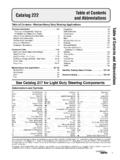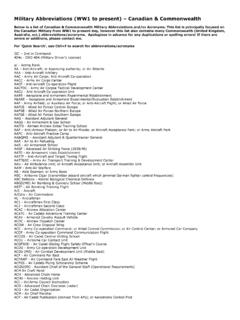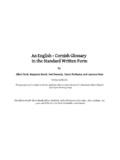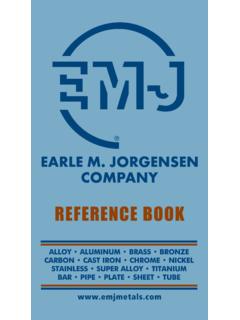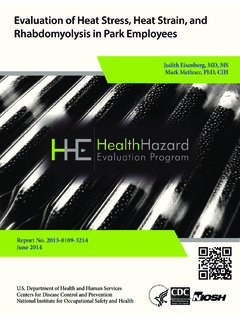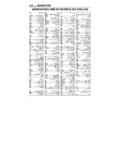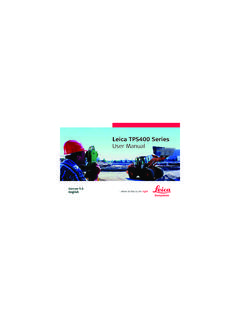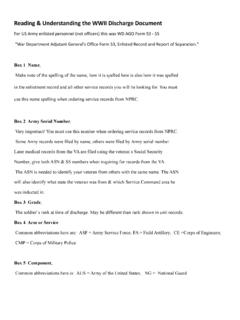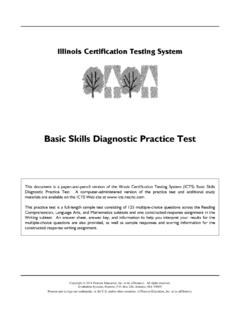Transcription of Pneumonia (Ventilator-associated [VAP] and non-ventilator ...
1 Device- associated Module PNEU. Pneumonia ( ventilator - associated [VAP] and non-ventilator - associated Pneumonia [PNEU]) Event Introduction: In 2011, an estimated 157,000 healthcare- associated pneumonias occurred in acute care hospitals in ; 39% of these pneumonias were ventilator - associated (VAP).1 Patients receiving invasive mechanical ventilation are at risk for numerous complications, including Pneumonia . ventilator - associated Pneumonia (VAP). and other healthcare- associated pneumonias are important, common healthcare- associated infections, but national surveillance for VAP has long been a challenge because of the lack of objective, reliable definitions. Due to these challenges, in January 2013 the National Healthcare Safety Network (NHSN) replaced surveillance for ventilator - associated Pneumonia (VAP) in adult inpatient locations with surveillance for ventilator - associated events (VAE).2 Based on discussions with an expert working group in 2012-2013, NHSN also discontinued in-plan VAP surveillance in neonatal locations.
2 As of January 2014, in-plan VAP surveillance is only available in pediatric inpatient locations. Settings: Surveillance may occur in any inpatient pediatric location where denominator data can be collected, such as critical/intensive care units (pedICUs), specialty care areas (SCA), step-down units, wards, and long term care units. In-plan surveillance for ventilator - associated Pneumonia (pedVAP) using the criteria found in this chapter is restricted to patients of any age in pediatric locations (excludes neonatal locations). In- plan surveillance conducted for mechanically-ventilated patients in adult locations (regardless of age) will use the ventilator - associated Event (VAE) protocol (see VAE. chapter). The PNEU definitions are still available for those units seeking to conduct off- plan PNEU surveillance for mechanically-ventilated adult, pediatric and neonatal patients and non-ventilated adults, pediatric or neonatal patients. A complete listing of inpatient locations and instructions for mapping can be found in the CDC Locations and Descriptions chapter.
3 Note: If you are following pedVAP in your monthly reporting plan it is not required to monitor for VAPs after the patient is discharged from the facility. However, if discovered, any VAPs with event date on the day of discharge or day after discharge should be reported to NHSN (see Transfer Rule below). No additional ventilator days are reported. Definitions: Present on Admission (POA): Infections that are POA, as defined in Chapter 2, are not considered HAIs and therefore are never reported to NHSN. Note: POA reporting exception for PNEU/VAP: One eligible chest imaging test is acceptable to satisfy the imaging parameter for PNEU/VAP-POA determinations regardless of whether the patient has underlying pulmonary or cardiac disease. January 2018 6-1. Device- associated Module PNEU. Healthcare- associated infections (HAI): All NHSN site-specific infections must first meet the HAI definition as defined in Chapter 2 before a site-specific infection can be reported to NHSN. Note: For patients with underlying pulmonary or cardiac disease who are required to have serial imaging test results, to satisfy the PNEU/VAP definitions, the second imaging test must occur within seven days of the first but is not required to occur within the Infection Window Period.
4 The date of the first CXR will be utilized when determining if the PNEU/VAP criteria are met within the infection window period. All other elements of PNEU/VAP definition must be present within the infection window period. Pneumonia (PNEU) is identified by using a combination of imaging, clinical and laboratory criteria. The following pages detail the various criteria that may be used for meeting the surveillance definition of healthcare- associated Pneumonia (Tables 1-4 and Figures 1 and 2), general comments applicable to all site-specific criteria, and reporting instructions. Table 5 shows threshold values for cultured specimens used in the surveillance diagnosis of Pneumonia . Date of event: For a PNEU/VAP the date of event is the date when the first element used to meet the PNEU infection criterion occurred for the first time within the 7-day Infection Window Period. ventilator : any device used to support, assist or control respiration (inclusive of the weaning period) through the application of positive pressure to the airway when delivered via an artificial airway, specifically an oral/nasal endotracheal or tracheostomy tube.
5 Note: Ventilation and lung expansion devices that deliver positive pressure to the airway (for example: CPAP, Bipap, bi-level, IPPB and PEEP) via non-invasive means (for example: nasal prongs, nasal mask, full face mask, total mask, etc.) are not considered ventilators unless positive pressure is delivered via an artificial airway (oral/nasal endotracheal or tracheostomy tube). ventilator - associated Pneumonia (VAP): A Pneumonia where the patient is on mechanical ventilation for >2 calendar days on the date of event, with day of ventilator placement being Day 1, *. AND. the ventilator was in place on the date of event or the day before. *If the ventilator was in place prior to inpatient admission, the ventilator day count begins with the admission date to the first inpatient location. January 2018 6-2. Device- associated Module PNEU. General Comments Applicable to All Pneumonia Specific Site Criteria: Physician's diagnosis of Pneumonia alone is not an acceptable criterion for POA. (present on admission) or HAI (healthcare- associated ) Pneumonia .
6 Although specific criteria are included for infants and children and immunocompromised patients, all patients may meet any of the other Pneumonia site-specific criteria. Pneumonia due to gross aspiration (for example, in the setting of intubation in the field, emergency department, or operating room) that meets the PNEU/VAP. definition with a date of event during the HAI timeframe is considered healthcare- associated (HAI). Multiple episodes of healthcare- associated Pneumonia may occur in critically ill patients with lengthy hospital stays. When determining whether to report multiple episodes of healthcare- associated Pneumonia in a single patient, follow the Repeat Infection Timeframe (RIT) guidance found in Chapter 2. Excluded organisms that cannot be used to meet the PNEU/VAP definition are as follows: 1. Normal respiratory flora, normal oral flora, mixed respiratory flora, . mixed oral flora, altered oral flora or other similar results indicating isolation of commensal flora of the oral cavity or upper respiratory tract 2.
7 The following organisms unless identified from lung tissue or pleural fluid specimens: i. Candida species* or yeast not otherwise specified ii. coagulase-negative Staphylococcus species iii. Enterococcus species Note: Candida species* or yeast not otherwise specified, coagulase- negative Staphylococcus species, and Enterococcus species identified from blood cannot be deemed secondary to a PNU2 or PNU3, unless the organism was also identified from a pleural fluid or lung tissue specimen *Candida species identified from sputum, tracheal aspirate, endotracheal aspirate, broncho-alveolar lavage (BAL) specimens or protected specimen brushing combined with a matching organism identified from a blood specimen can be used to satisfy the PNU3 definition. 3. Additionally, because organisms belonging to the following genera are typically causes of community- associated infections and are rarely or are not known to be causes of healthcare- associated infections, they are also excluded, and cannot be used to meet any NHSN definition: Blastomyces, Histoplasma, Coccidioides, Paracoccidioides, Cryptococcus and Pneumocystis.
8 January 2018 6-3. Device- associated Module PNEU. Abbreviations used in the PNEU laboratory criteria: BAL bronchoalveolar lavage EIA enzyme immunoassay IFA immunofluorescent antibody LRT lower respiratory tract PMN polymorphonuclear leukocyte RIA radioimmunoassay Reporting Instructions: There is a hierarchy of specific categories within the major site Pneumonia . If the patient meets criteria for more than one specific site during the infection window period or the RIT, report only one: o If a patient meets criteria for both PNU1 and PNU2, report PNU2. o If a patient meets criteria for both PNU2 and PNU3, report PNU3. o If a patient meets criteria for both PNU1 and PNU3, report PNU3. Pathogens and secondary bloodstream infections can only be reported for PNU2 and PNU3 specific events. Report concurrent LUNG and PNEU with at least one matching organism(s) as PNEU. January 2018 6-4. Device- associated Module PNEU. Table 1: Specific Site Algorithms for Clinically Defined Pneumonia (PNU1).
9 Imaging Test Signs/Symptoms/Laboratory Evidence Two or more serial chest For ANY PATIENT, at least one of the following: imaging test results with at least one of the Fever (> C or > F). following1,2,14: Leukopenia ( 4000 WBC/mm3) or leukocytosis (>12,000 WBC/mm3). For adults >70 years old, altered mental status with no other recognized cause New and persistent or And at least two of the following: Progressive and persistent New onset of purulent sputum3 or change in character of sputum4, or increased respiratory secretions, or increased suctioning requirements Infiltrate New onset or worsening cough, or dyspnea, or tachypnea 5. Rales6 or bronchial breath sounds Consolidation Worsening gas exchange (for example: O2 desaturations (for example: PaO2/FiO2. <240)7, increased oxygen requirements, or increased ventilator demand). Cavitation ALTERNATE CRITERIA, for infants <1 year old: Pneumatoceles, in infants 1 year old Worsening gas exchange (for example:2 desaturations [for example pulse oximetry <94%], increased oxygen requirements, or increased ventilator demand).
10 Note: In patients And at least three of the following: without underlying pulmonary or cardiac Temperature instability disease (for example: Leukopenia ( 4000 WBC/mm3) or leukocytosis (>15,000 WBC/mm3) and left shift respiratory distress (>10% band forms). syndrome, New onset of purulent sputum3 or change in character of sputum4, or increased bronchopulmonary respiratory secretions or increased suctioning requirements dysplasia, pulmonary edema, or chronic Apnea, tachypnea5 , nasal flaring with retraction of chest wall or nasal flaring with obstructive pulmonary grunting disease), one definitive Wheezing, rales6, or rhonchi imaging test result is Cough Bradycardia (<100 beats/min) or tachycardia (>170 beats/min). ALTERNATE CRITERIA, for child >1 year old or 12 years old, at least three of the following: Fever (>38. 0 C or >100. 4 F) or hypothermia (<36. 0 C or <96. 8 F). Leukopenia ( 4000 WBC/mm3) or leukocytosis ( 15,000 WBC/mm3). New onset of purulent sputum3 or change in character of sputum4, or increased respiratory secretions, or increased suctioning requirements New onset or worsening cough, or dyspnea, apnea, or tachypnea 5.










